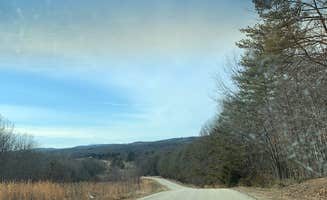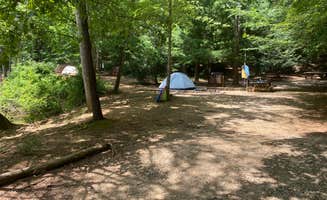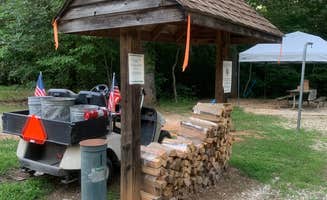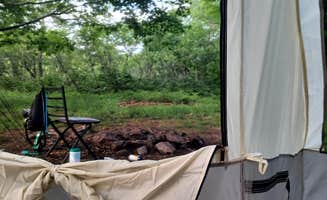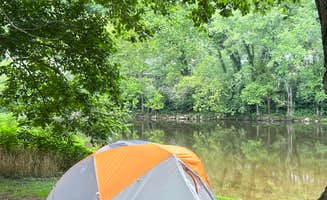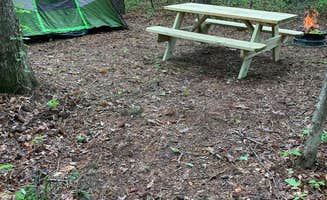Tent camping opportunities around Amherst, Virginia span across multiple state parks and national forest land within a 15-mile radius. The area sits in Virginia's Piedmont region at elevations ranging from 700 to 1,500 feet, with the James River creating a distinct watershed that influences local camping conditions. Summer temperatures typically reach 85-90°F during peak season, while spring and fall offer milder conditions in the 60-75°F range.
What to do
Fishing access: James River State Park offers exceptional fishing directly from your campsite. As one camper at Canoe Landing Group Campsite noted, "You can fish right off the bank less than 50 yards from your tent." The river contains smallmouth bass, catfish, and sunfish species throughout the camping season.
Stargazing opportunities: The area provides excellent night sky viewing with minimal light pollution. A camper at Walnut Grove remarked, "The beat place for star gazing! Just ask for a telescope (free at the store) and stare up at the sky for hours!" Some campgrounds offer loaner telescopes during clear weather conditions.
Paddling routes: Multiple put-in points along the James River create paddling opportunities ranging from 1-6 miles. According to one visitor, "We usually launch our kayaks from Mimosa Boat Landing across the lake. The overnight parking is $10. It takes us about 20 min to get to the site." Most routes feature calm water suitable for beginners, though water levels fluctuate seasonally.
What campers like
Privacy between sites: Many campers appreciate the spacing between tent sites, particularly at certain campgrounds. A visitor to Branch Pond commented, "Branch Pond campsite provides for so much more privacy than Canoe Landing. The sites are larger too!" Sites in the more remote areas typically offer 50-100 feet of separation between neighbors.
Clean facilities: Campers frequently mention the well-maintained bathhouses and facilities. One camper noted, "The bathhouse was immaculate and the campsite large enough for two tents to share comfortably." Most established campgrounds feature regular cleaning schedules and updated facilities.
River proximity: Direct access to water ranks high among camper preferences. At Breeden Bottom Campground, "Sites are spacious and right along the river. Most sites have river access directly from the site. The James river is perfect for kayaking/SUP/canoeing and even swimming, nice and calm." Many riverside sites include small clearings leading directly to water access points.
What you should know
Train noise: Some riverside campgrounds experience occasional train disruptions. As one camper at Breeden Bottom Campground mentioned, "The train was loud at times, but we knew that would happen when we booked the site, so no surprises there." Trains typically pass 2-3 times daily along certain sections of the James River.
Cell service limitations: Connectivity varies significantly across camping areas. At Dispersed Camping Site off FR 812, one camper reported, "No cell service (T-Mobile), but if I drove towards the main road, Route 501, I could get some service." Verizon generally provides the most reliable coverage in the region.
Transportation challenges: Many tent sites require additional effort to reach. A reviewer noted, "It is a very rocky path, about 50 feet long, to get into the campground, but then it is smooth and well laid out." Walk-in sites often require campers to transport gear 50-200 feet from parking areas, sometimes across uneven terrain.
Tips for camping with families
Kid-friendly ranger programs: Several state park locations offer structured activities for children. One visitor mentioned, "My 4 yr old spent hours playing with all the little animals the ranger station had." Programs typically run on weekends during summer and major holidays.
Swimming considerations: River access points vary in suitability for children. A camper cautioned, "Would be careful swimming with children. Most areas are very calm but the river can get rapid at times!" Designated swimming areas provide safer options during summer months.
Space for activities: Hog Camp Gap offers substantial open areas for family recreation. One camper described, "The campground is roughly the size of a Walmart parking lot including the store or three football fields." These larger camping areas provide room for games and activities away from camping equipment.
Tips from RVers
Site size considerations: Level sites accommodate varying RV lengths at select campgrounds. A visitor to Wildwood Campground (now Lynchburg KOA) observed, "Sites are huge and level. It's quiet and peaceful, and the surrounding area is gorgeous." Most RV-friendly sites can accommodate units up to 30 feet, with a limited number of larger sites available.
Road access challenges: Reaching some campgrounds requires navigating narrow roads. One camper noted, "Located in the middle of nowhere off of narrow Virginia secondary roads, we were surprised to get good Verizon reception." RVs over 25 feet should check road conditions before attempting access to more remote camping areas, especially after weather events.
Hookup availability: Water and electric connections vary across campgrounds. A visitor mentioned, "We stayed on site 15 which is a long pull-thru. As with other VA State Parks, we picked our site once we arrived." Most state park campgrounds offer electric/water hookups, while national forest sites provide no utilities.


